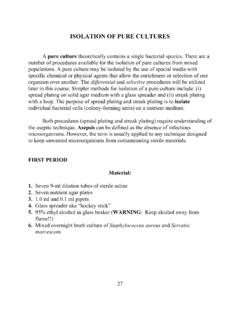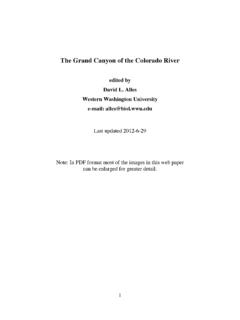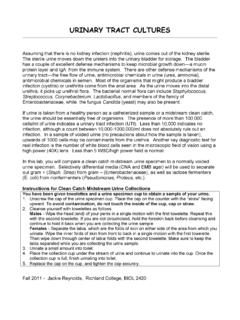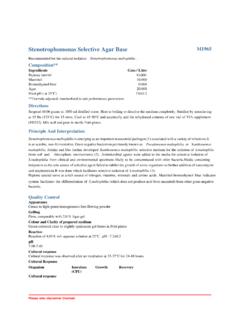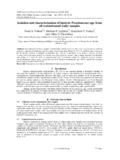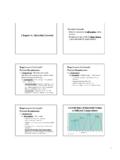Transcription of SELECTIVE AND DIFFERENTIAL MEDIA - OpenWebMail
1 49 SELECTIVE AND DIFFERENTIAL MEDIAS elective and DIFFERENTIAL MEDIA are used to isolate or identify particularorganisms. SELECTIVE MEDIA allow certain types of organisms to grow, and inhibitthe growth of other organisms. The selectivity is accomplished in several example, organisms that can utilize a given sugar are easily screened bymaking that sugar the only carbon source in the medium . On the other hand, SELECTIVE inhibition of some types of microorganisms can be achieved by addingdyes, antibiotics, salts or specific inhibitors which affect the metabolism orenzyme systems of the organisms. For example, MEDIA containing potassiumtellurite, sodium azide or thallium acetate (at concentrations of - g/l) willinhibit the growth of Gram-negative bacteria. MEDIA supplemented with penicillin(5-50 units/ml) or crystal violet (2 mg/l) will inhibit the growth of Gram-positivebacteria.
2 Tellurite agar, therefore, is used to select for Gram-positive organisms,and nutrient agar supplemented with penicillin can be used to select for Gram-negative MEDIA are used to differentiate closely related organisms orgroups of organisms. Owing to the presence of certain dyes or chemicals in themedia, the organisms will produce characteristic changes or growth patterns thatare used for identification or differentiation. A variety of SELECTIVE and differentialmedia are used in medical, diagnostic and water pollution laboratories, and in foodand dairy laboratories. Three of the more common SELECTIVE and DIFFERENTIAL mediaare described below and will be used in the laboratory SALT AGAR (MSA)Mannitol salt agar is a SELECTIVE medium used for the isolation of pathogenicstaphylococci. The medium contains mannitol, a phenol red indicator, and chloride. The high salt concentration inhibits the growth of most bacteriaother than staphylococci.
3 On MSA, pathogenic Staphylococcus aureus producessmall colonies surrounded by yellow zones. The reason for this change in color isthat S. aureus ferments the mannitol, producing an acid, which, in turn, changesthe indicator from red to yellow. The growth of other types of bacteria is METHYLENE BLUE AGAR (EMB agar)Eosin methylene blue agar is a DIFFERENTIAL medium used for the detectionand isolation of Gram-negative intestinal pathogens. A combination of eosin andmethylene blue is used as an indicator and allows differentiation betweenorganisms that ferment lactose and those that do not. Saccharose is also includedin the medium because certain members of the Enterobacteria or coliform groupferment saccharose more readily than they ferment lactose. In addition, methyleneblue acts as an inhibitor to Gram-positive of E. coli normally have a dark center and a greenish metallicsheen, whereas the pinkish colonies of Enterobacter aerogenes are usually mucoidand much larger than colonies of E.
4 Coli. Other organisms, such as Salmonella(one of the causative agents of food poisoning), do not ferment lactose orsaccharose and produce colonies that are 'S AGARMacConkey's agar is a DIFFERENTIAL plating medium used in the detectionand isolation of all types of dysentery, typhoid and paratyphoid organisms. It isgenerally used for differentiating strains of Salmonella typhosa from members ofthe coliform group; however, the medium supports the growth of all Salmonellaand Shigella strains and gives good differentiation between these entericpathogens and the coliform group. When grown on MacConkey s medium ,colonies of coliform bacteria are brick-red in color and are surrounded by a zoneof precipitated bile. These reactions are due to the acid produced by thefermentation of lactose. The acid end-products act on bile salts, and neutral red isabsorbed by the precipitated salts.
5 Dysentery, typhoid and paratyphoid bacilli donot ferment lactose but give an alkaline reaction when grown on the of these organisms are noncolored and transparent. The growth of Gram-positive organisms is inhibited because of the crystal violet and bile salts in PERIODM aterial:1. Cultures of:Staphylococcus aureusStaphylococcus epidermidisEscherichia coliEnterobacter aerogenesSalmonella dishes of Mannitol Salt agar, EMB agar, MacConkey's agar and nutrientagarProcedure: (work in pairs) each plate of MSA and MacConkey's agar into two sections. Divide theEMB agar plate into three the MSA plate with S. aureus and S. MacConkey's agar with E. coli and Salmonella the 3-sectional EMB agar plate with E. coli, Enterobacter aerogenes,and Salmonella one plate of nutrient agar into two sections and one into three the 2-sectional plate with the two species of Staphylococcus;inoculate the 3-sectional plate with the remaining three all plates at 37 C for 48 the growth and appearance of colonies on all plates.
6 Notice thatnutrient agar is neither a SELECTIVE nor DIFFERENTIAL OF THE BODY: GRAM-POSITIVE COCCIThe bodies of mammals, molluscs, insects and other representatives of the animal kingdom are natural habitats for microorganisms. Many microorganismsexist in balanced symbiosis with host organisms. That is, the microorganisms growon the surface of the animal hosts including, of course, the internal surfaces of thegastrointestinal, genitourinary, and respiratory tracts. They grow without causingmeasurable damage to the host. In some cases, the microorganisms actually benefitthe host by producing useful compounds such as vitamins, or by preventing accessto tissues by pathogenic microorganisms. There are also those microorganismswhich can damage the host; they are termed pathogenic because of their ability tocause of the major morphological groups associated with animal hosts arethe cocci.
7 Some of the most important cocci are the Gram-positive cocci belongingto the genera Staphylococcus and Streptococcus and the Gram-negative coccibelonging to the genus Neisseria. One species of the genus Staphylococcus isStaphylococcus epidermidis, which is commonly found on the skin of humans andwhich is rarely associated with disease. Staphylococcus aureus, on the other hand,is associated with a wide variety of disease states, including impetigo, toxic shocksyndrome and food poisoning. S. aureus is also found in the normal flora of thenasopharynx of about 40% of the human population. This shows that disease doesnot result simply from the presence of the disease-causing agent, but is alsoaffected by factors such as the physiological state of the host and the virulence(degree of pathogenicity) of the particular strain of genus Streptococcus also contains both pathogenic and nonpathogenicspecies.
8 Examples of nonpathogenic streptococci are the lactic acid bacteriawhich are associated with the normal flora of both animals and plants, andgenerally cause no adverse effects. Other streptococci are pathogenic. Forexample, Streptococcus pyogenes and Streptococcus pneumoniae cause a widerange of diseases including strep throat, pneumonia, scarlet fever and acuterheumatic , both nonpathogenic and pathogenic species occur in the Gram-negative cocci of the genus Neisseria. For example, Neisseria meningitidis andNeisseria gonorrhoeae are the causative agents of meningitis and gonorrhea, between these groups of cocci is easy. Neisseria are oxidase-positive, Gram-negative, kidney bean-shaped cells often found in are Gram-positive, catalase-positive cocci usually found singly orin clusters. Streptococcus are Gram-positive, catalase-negative cocci often foundin chains.
9 Differentiating between the species within a genus is more complex, butobviously necessary for proper diagnosis of disease. In this exercise, we willisolate cocci from the human body and identify some of the isolates. BIOCHEMICAL REACTIONS USED FOR IDENTIFICATION OF GRAM-POSITIVE COCCICATALASED uring aerobic respiration, microorganisms produce hydrogen peroxide(H2O2). This compound is toxic, and accumulation of the substance will result indeath of the organism unless it can be enzymatically degraded to water H2O2 2 H2O + O2 Catalase is the enzyme responsible for degradation of hydrogen peroxide. Todetermine the catalase activity of a bacterial culture, a solution of dilute H2O2 isadded to a bacterial smear on a glass slide. The formation of bubbles (O2) isevidence of catalase activity. Catalase is invariably present in aerobes and is alsopresent in some facultative organisms.
10 As a DIFFERENTIAL test, the catalase test isused to distinguish between streptococci (catalase negative) and staphylococci(catalase positive).54 COAGULASEP roduction of coagulase is indicative of a pathogenic staphylococcal species(Staphylococcus aureus). Coagulase acts by a thrombinase-like action. In normalblood clotting, the following reactions occur:prothrombin + CaCl2 prothrombinase > thrombinthrombin + fibrinogen thrombinase > fibrin (clot)Coagulase acts within host tissues to convert fibrinogen to thrombin. It istheorized that the fibrin meshwork that is formed surrounds the bacterial cells orinfected tissues, protecting the organism from nonspecific host defensemechanisms such as phagocytosis. A coagulase-positive strain of Staphylococcus will cause fibrin formation, will clot plasma. Clot formation within 4 hours is interpreted as a positiveresult and indicates a virulent S.
